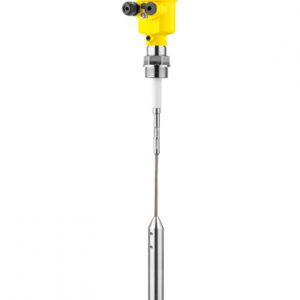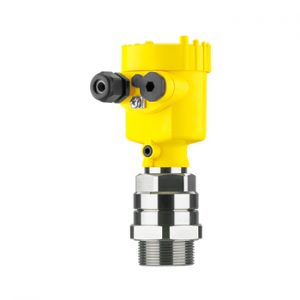Description
The VEGAFLEX 82 allows maintenance-free measurement of light and heavy bulk solids. Even in applications with strong dust generation, condensation or buildup, the sensor delivers precise and reliable measured values. Automatic probe end tracking enables measurement of virtually any kind of bulk solid material.
Your benefit
- The guided adjustment enables a simple, time-saving and reliable setup
- Shortenable probes offer a simple standardisation and highest flexibility in the planning
- Virtually all bulk solids can be measured with the automatic probe end tracking
Application area
Cable or rod sensor. Even in applications with large amounts of dust, condensation or buildup, the sensor delivers precise and reliable readings.
Guided level radar – ideal for measurement of all bulk solids
Optimised for measuring bulk solids, VEGAFLEX 82 guided level radar is ideal for use in many different industries – from chemicals to energy, cement plants to plastics manufacture and even grain storage. It is reliable and accurate, even when deployed in the typically difficult conditions of bulk solids measurement, such as dust, noise or varying dielectric constant.
Guided level radar does an excellent job in bulk solids applications, such as
- Level measurement in grain silos
- Level measurement in plastics
- Level measurement in cement silos
Buffer tank for spent grain
Malt is a key component in the production of beer. The malting process at the beginning of the production sequence has a major influence on the character of the resulting beer. After mashing, the malt and other ingredients together with the brewing water are filled from the mash container into the lauter tun and held there for several hours at process temperature. The hot liquid of the wort is then slowly strained through the malt cake and pumped into the wort container. The remaining malt or spent grain from the lauter tun is conveyed into a buffer tank and temporarily stored there. The lauter tun has to be emptied so that production can continue. The buffer tank is therefore a crucial point in the production process not only because it serves as an interim storage facility, but because from there the material is forwarded to the storage silos. Due to the high temperature of approx. 60° C and the high moisture content of the material, a vapour atmosphere of high humidity prevails in the container. This leads to heavy condensation and buildup on the installed measuring probe. From the buffer tank the spent grain is eventually passed on to the storage silos and stored until it is sold as protein-rich animal feed.
Filling silo for colour pigment
In the last production step, the finished pigment powders are pneumatically conveyed into packing silos. The conveying system generates very high dust levels and air movement inside the silos. To control the filling process, the levels in the silos need continuous monitoring. A high level detection switch is used for safety shutdown in case of overfilling. The pigment powder is then filled into sacks via the bottom outlet.
Lime silo II
For flue gas desulfurization a continuous production of the lime milk is required, the lime is kept on hand in sufficient quantities in large silos. Lime tends to readily adhere to more or less anything, depending on its type and consistency, interfering with equipment like the operation of instruments. A robust, non-susceptible level measurement is therefore absolutely necessary for reliable lime logistics and stocking. That’s why a non-contact measuring instrument that also works well in the very dusty environment is essential here.
Raw meal silo
Before being burned in the rotary kiln, the material from the blending bed and the aggregates are ground to a fine raw meal in large mills. The powdery material is then transported to the silo by a pneumatic conveyor system. Reliable monitoring of the level is essential for optimal raw material storage.
Learn more about Guided Wave Radars available at BBP.







